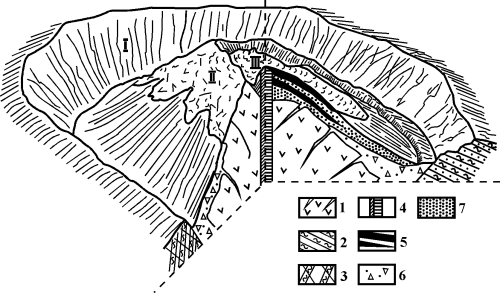Bezymyannyi: "Anatomy" of Volcano
By the time I began my observations, Bezymyannyi was a volcanic cone of
a complex type. The caldera that had been produced by a lateral blast in
1956 contained a dome, named Novyi, that had
grown in the explosion vent during the eruptions that followed the
blast. The dome consisted of two blocks: one of them, passive, in the west,
consisted of the old extrusive rocks of the earliest eruptions and exhibited
merely fumarolic activity throughout the period of study, the other, active,
in the east, composed of a stratovolcanic complex produced by the eruptions
of the previous years.
The picture may be enlarged by left mouse click
Bezymyannyi structure in 1979:
I - remains of old volcano, destroyed by directed eruption in 1956.
II - extrusive dome growing up in volcano's
crater after 1956.
III - active volcano's block. All eruptions from middle of the seventies
were associated with this block.
1 - extrusion rocks; 2 - old volcano's rocks; 3 - zone of fragmentation
in old volcanic structure; 4 - magmatic channel; 5 - lava flows; 6 - mantle
of extrusive dome; 7 - clastic deposits of last eruptions.
During the 1980s Volcano was in the intermediate state between the moderately
acid extrusive and the basic stratovolcanic activity as follows from its
rapid evolution in terms of the eruptive forms, the composition of the
juvenile material, and structural adjustment. This transition defined the
peculiar dynamics of its eruptions.

Сайт управляется системой
uCoz
